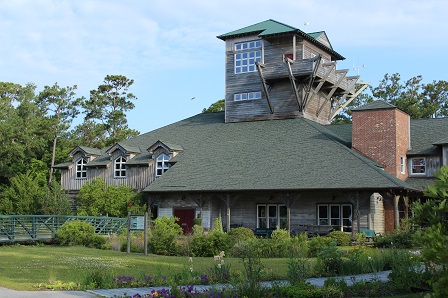NATURALIST’S NOTEBOOK: The Secret World of Red Wolves: The Fight to Save North America’s Other Wolf


If you’ve not yet heard a wild red wolf’s haunting howl, then plan to this spring or summer. It’s a sound you’ll not soon forget. The red wolf’s song is a blend of otherworldly forlorn pining, punctuated by a series of broken yaps, and it used to resonate throughout forests and coastal plains in the Southeast. Called “dogs of the woods” by early European explorers, red wolves are the region’s native wild canid.
An entirely unique species called Canis rufus, they are more closely related to coyotes than they are to gray wolves. Today, coastal North Carolina boasts the only wild population of C. rufus in the world.
My book, The Secret World of Red Wolves: The Fight to Save North America’s Other Wolf, traces the red wolf’s story from its evolutionary origins to its decline in the wild, its reintroduction 27 years ago, and the challenges of its management today. The book also looks at potential changes that could swamp or modify much of the red wolf’s only wild habitat — 1.7 million acres of the Albemarle Peninsula called the Red Wolf Recovery Area.
There’s not much in my world that beats getting up close and personal with an imperiled wild animal, and I believe most nature lovers share this sentiment. Which is why you might want to visit www.fws.gov/redwolf/howling.html to check out the 2014 schedule for red wolf howlings in their natural habitat.
To get you in the mood, here is an excerpt from my book, from Chapter Four: Howling Summer Nights. In this scene, I was participating in a nighttime howling safari on Alligator River National Wildlife Refuge within the Red Wolf Recovery Area. Kim Wheeler, from the Red Wolf Coalition, a nonprofit organization that raises private support for long-term red wolf restoration, led the tour. She had just departed from our group to begin eliciting howls from nearby red wolves.
We stand in a pool of weak, wobbly light cast from people’s flashlights and head lamps. The forest darkness encircles us. A few minutes later, we hear Kim’s call pierce the night air.
The buzz and drone of insects create a background of uneven noise that I strain to filter out. I hear Kim howl again, and everyone around me seems to be holding their breath and trying not to move. We listen and wait for an answer.
Nothing. Kim tries again. No response.

I wonder what the people in the crowd are thinking. Is this all just a sham? Just another tourist attraction?
Kim makes a fourth howl, and then it starts. A lone howl rises, forlorn and low. It meanders through a few octaves and claws higher and higher. It trails into a thin high-pitched note, and then a second and a third howl pick up at lower pitches. People in the crowd gasp, some lean forward straining to hear. Within thirty seconds, a parade of howls sings loudly from the dark woods. It is hard to believe the wolves are a few hundred yards away. They sound much closer, perhaps less than a hundred feet.
Kim walks back to the crowd, flashlight downturned on the ground. Howls waft from somewhere behind her, persistent but not aggressive. The wolves sing. They sing to each other as much as they sing to us. One pitch stands out from the others, higher, thinner, and much lighter. It must be the pup. I imagine him standing next to his parents, watching them throw their heads back and open their jaws wide, letting loose with a call that says, “Here we are! Where are you? Here we are!” And the pup joins in, calling, “I’m here too! I’m here too!” I don’t know exactly what these wolves are saying, of course, but it is difficult to imagine the howling being anything other than a communication to locate other packs or individuals, a way to call out to the night and exclaim: I am here, and I know how to take care of myself so well that I’m going to let you know that I’m here! And my mate is here, and my kids are here. We are all here together in this place that is ours.
After a minute of steady howling, the wolves’ entwined calls dwindle out to one lone call that seems to pivot between notes before ending in a series

of high, broken yips. Kim asks all the kids to come to the front of our bunched group. Children filter forward, wide-eyed in the forested night, clutching flashlights close to their chests. Kim instructs them to howl on the count of three, and they let loose with a careening, loud set of human yowls. A short while later, the wolves answer back again, proclaiming their space and presence in the night. The children grin, entranced by this tenuous connection to a wild and unseen creature. After the kids, it is the adults’ turn.
“Dig deep and howl!” Kim instructs gleefully. “Howling is the best stress reliever in the world. If you are on vacation here, you must howl,” she jokes. We howl on her count, and the wolves answer a third time. Their howls seem to weave in and out of each other as they change pitch and perhaps meaning. Kim is excited that we got three responses from them and also heard the puppy. “We really rocked it tonight!” she exclaims, pumping her fist in the air. Everyone is smiling.
It is never certain for her that the wolves will answer each Wednesday. I wonder for a moment why they do. Surely they know that these are just a bunch of humans trying to speak wolf. Surely they smell us, a group of sixty people cloaked in lotions, colognes, insecticides, and deodorant — announcing our odiferous presence to an animal whose world is ordered by scent — standing in the woods a mere few hundred yards away. Surely they heard our engines as we arrived. Surely they could hear that our pitch is off, that we are an imitation. Yet they accept this and play along. Why?

Wolves, it turns out, will howl to a variety of stimuli, including the sirens of emergency responder vehicles. In the late 1960s, when researchers discovered that the red wolf was nose-diving into extinction, they played electronic sirens in southeastern Texas coastal marshes and plains to elicit howls from wild canids. From the howls, they made probable identifications of red wolves and possible hybrids. Coyote vocalizations often have a series of broken yips and barks and emanate at a comparatively higher frequency, whereas red wolves will howl at lower frequencies that start “deep and mournful” but may break off into yapping like a coyote, according to a report authored in 1972 by two trappers, Glynn Riley and Roy McBride, who were employed by the federal government. Early surveyors noted, too, that the red wolves were more likely to howl in good weather and less likely to respond in rainy or overcast weather.
Confined to their facility, perhaps the red wolves of Sandy Ridge howl to humans because it gives them a way to communicate with living beings outside their fence. Who knows: maybe they are simply telling us to bugger off and go away. Or, as frightened as they are of seeing a human, perhaps howling to a group of them on a dark night is more palatable since they do not have to look at us or be gawked at in turn. Perhaps howling is a way of reaching out on their own terms, in their own language, through which they can proclaim their space and their place on the land — their way of saying, “Even though I’m in here, behind this fence, I own this place.”
Or maybe they just want to remind us that this land had been theirs for millennia before we invaded and claimed it. In the dark of night, I fantasize that their howls are calling out: “All this was ours. This was ours.”
Excerpt from The Secret World of Red Wolves: The Fight to Save North America’s Other Wolf by T. DeLene Beeland. Copyright © 2013 by T. DeLene Beeland. Used by permission of the University of North Carolina Press, www.uncpress.unc.edu.
This article was published in the Winter 2014 issue of Coastwatch.
For contact information and reprint requests, visit ncseagrant.ncsu.edu/coastwatch/contact/.
- Categories:


